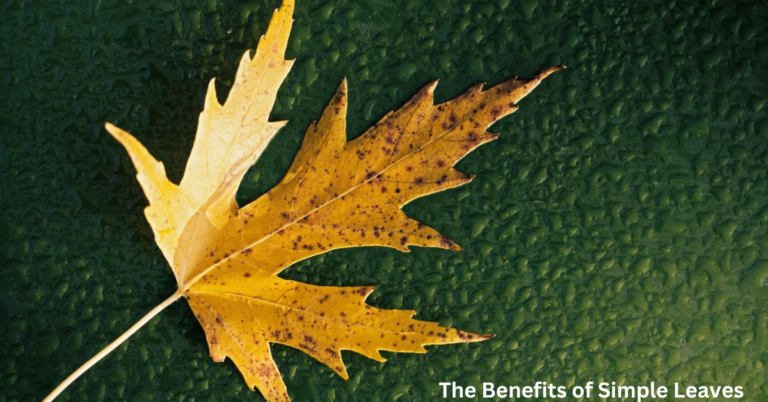Introduction
Plants play a crucial role in our daily lives, providing oxygen, food, and a connection to nature. Among the various components of plants, leaves hold significant importance. Leaves come in different shapes, sizes, and types, each serving a unique purpose. In this article, we will explore the world of simple leaves, understanding their characteristics, uses, and health benefits.
Understanding Simple Leaves
Simple leaves, as the name suggests, are left that have a single leaf blade attached to a stem or petiole. They are distinct from compound leaves, which have multiple leaflets. Simple leaves,s can be identified based on certain characteristics. They have a single main vein, known as the midrib, from which smaller veins branch out, forming a network throughout the leaf.
There are two primary types of simple leaves:
Broadleaf simple leaves and needle-like simple leaves. Broadleaf simple leaves are flat and wide, characterized by their broad shape. Examples of broad leaf simple leaves include those of maple trees, oak trees, and sunflowers. On the other hand, needle-like simple leaves are long, slender, and often pointed. Common examples,s of needle-like simple leaves can be found on pine trees, spruces, and firs.
Uses of Simple Leaves
Ornamental Purposes:
Simple leaves are widely used for ornamental purposes in landscaping and gardening. The broad variety of shapes, sizes, and colors make them versatile for creating visually appealing landscapes. Simple leaves can add texture, color, and dimension to gardens, parks, and other outdoor spaces. Additionally, they are often incorporated into indoor decoration, bringing a touch of nature and freshness to interior spaces.
Medicinal and Therapeutic Uses:
Throughout history, various cultures have harnessed the medicinal properties of simple leaves for traditional and herbal medicine. Many leaves possess beneficial compounds such as antioxidants, anti-inflammatory agents, and antimicrobial properties. For example, the leaves of neem trees have been used in Ayurvedic medicine for their antibacterial and antiviral properties. Simple leaves like eucalyptus are known for their respiratory benefits, helping to alleviate coughs and congestion.
Culinary Applications:
Simple leaves are edible and widely used in culinary practices. Fresh herbs such as basil, parsley, and cilantro are poplars examples. These leaves not only enhance the flavor and aroma of dishes but also provide nutritional value. Simple leaves can be used in salads, sauces, marinades, and various recipes to add a refreshing and aromatic touch to the culinary experience.
Simple Leaves and Environmental Impact
Oxygen Production:
Simple leaves play a crucial role in photosynthesis, the process by which plants convert sunlight, carbon dioxide, and water into glucose and oxygen. Through this process simple leaves release oxygen into the atmosphere, replenishing the air we breathe. They contribute significantly to improving air quality and reducing the concentration of carbon dioxide, a greenhouse gas responsible for climate change.
Ecosystem Support:
Simple leaves provide a habitat and food source for numerous organisms. Birds, insects, and other small animals often rely on leaves for shelter, nesting, and as a food source. Leaves also support the growth of beneficial microorganisms in the soil, contributing to the overall health and balance of ecosystems. By preserving and caring for simple leaves, we contribute to the conservation of biodiversity and the sustainability of our environment.
Caring for Simple Leaves
Here are some tips to keep in mind:
Light and Temperature Requirements:
Different simple leaves have varying light preferences. Some thrive in full sun, while others prefer partial shade. It is crucial to understand the specific light requirements of the simple leaves you have and provide them with the appropriate lighting conditions. Similarly, temperature considerations are important. Some simple leaves prefer cooler temperatures, while others thrive in warmer climates. Understanding the temperature requirements of your simple leaves will help ensure their optimal growth and overall health.
Watering and Fertilization:
Proper watering techniques are essential for simple leaf plants. Overwatering can lead to root rot, while underwatering can cause wilting and dehydration. It’s import ants to find the right balance by checking the soil moisture regularly and watering accordingly. Additionally, providing’s appropriate fertilization can enhance the growth and vitality of simple leaves. Use a balanced fertilizer specifically formulated for foliage plants, following the recommended application instructions.
Pruning and Maintenance:
Regular pruning is necessary to maintain the health and shape of simple leaves. Removing dead or damaged leaves promotes new growth and prevents the spread of diseases. Additionally, pruning helps manage the size of the plant and enhances its overall appearance. Simple leaves may require occasional cleaning to remove dust and debris, allowing them to breathe and absorb sunlight more effectively. Wiping the leaves gently with a damp cloth can help keep them clean and healthy.
Conclusion
Simple leaves with their diverse shapes, sizes, and characteristics, offer numerous benefits and uses. They contribute to the aesthetic appeal of our surroundings through landscaping and indoor decoration. Additionally, simple leaves have been used for centuries in traditional medicine for their healing properties. Incorporating edible leaves into culinary practices adds flavor, nutrition, and a touch of nature to our meals.
Furthermore, simple leaves play a vital role in the environment by producing oxygen through photosynthesis and supporting the ecosystem by providing habitat and food for various organisms. By caring for simple leaves and understanding their specific needs, we can contribute to a greener and healthier planet.
Whether you’re a gardening enthusiast, a nature lover, or someone interested in the therapeutic benefits of plants, simple leaves are a valuable resource to explore. Embrace their beauty, harness their health benefits, and play your part in preserving the environment. We can create a more sustainable and harmonious relationship with the natural world by appreciating and caring for simple leaves.


